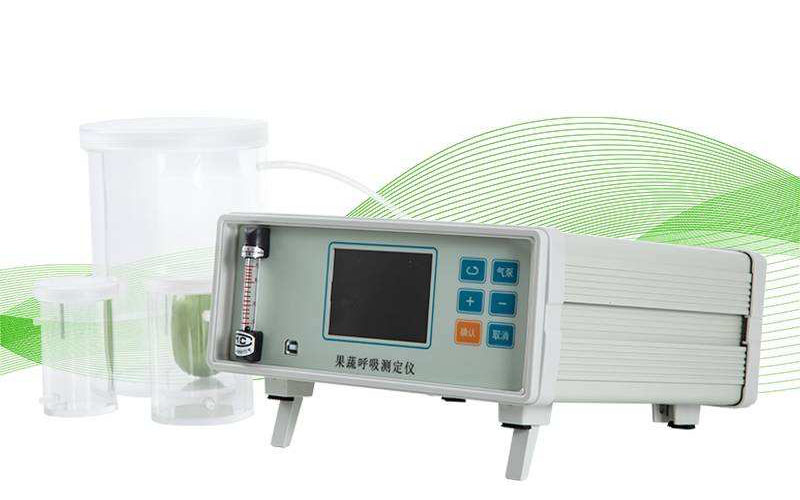Fruit and Vegetable Respirometer
If you are in the fruit and vegetable business, you know that keeping fruits and vegetables fresh is unavoidable. However, in the process of fruit and vegetable storage, if the respiration is too high, it will affect the effect of storage. Therefore, to prolong the storage time of fruits and vegetables and improve the effect of storage, it is necessary to use a fruit and vegetable respirator to measure, analyze and study the respiration intensity of fruits and vegetables during storage, and take this as a guide to take reasonable measures to store fruit and vegetable products.
Generally speaking, the respiration intensity of fruits and vegetables is represented by CO2 concentration or O2 concentration, and the respiration intensity of fruits and vegetables is closely related to temperature and humidity. Therefore, concentration, temperature, and humidity, so the CO2 concentration can represent the respiration intensity of fruits and vegetables, and the O2 concentration can also be used to represent the respiration intensity of fruits and vegetables, which is more comprehensive. In addition, the storage methods of fruits and vegetables mainly include normal temperature, refrigerator, controlled atmosphere storage, supermarket freezer, etc. Therefore, the Grain and Vegetable Respiration Tester is a special instrument for measuring the respiratory intensity of vegetables under these different storage conditions.
The fruit and vegetable breathometer is specially used to measure and research the breath intensity of fruits and vegetables under the storage conditions of normal temperature, refrigerators, controlled atmosphere storage, supermarket freezers, etc. The characteristics of the fruit and vegetable respirator are that different volumes of breathing chambers can be selected according to the size of fruits and vegetables, which speeds up the balance and measurement time; the instrument can simultaneously display the CO2 concentration, O2 concentration, temperature and humidity of the breathing chamber; CO2 concentration and O2 concentration can be used. Two ways to express breathe. Compared with the previous CO2 measuring instrument, it has the characteristics of multi-function, high precision, fast, efficiency, and convenience. It is suitable for food, gardening, fruit, vegetables, foreign trade, and other schools, research institutes, and companies Respirometry for various fruits and vegetables.
Significance of Fruit and Vegetable Respirometer
With the development of modern society, people have higher and higher requirements for the freshness of fruits and vegetables. Therefore, it is necessary to consider how to improve and maintain the freshness of fruits and vegetables for large-scale vegetable planting bases, vegetable testing bases, vegetable storage rooms, etc. In storage, the main reproduction of life activities is respiration. The essence of respiration is a slow biological oxidation-reduction process through many intermediate reactions with the participation of a series of specialized enzymes. Respiration is the process of gradually oxidizing and decomposing complex organic substances in cell tissues into simple substances, and finally into carbon dioxide and water, and at the same time releasing energy. Therefore, to reduce respiration in fruit and vegetable storage, it is necessary to reduce temperature, reduce humidity, reduce oxygen concentration, increase carbon dioxide concentration, and use hormones that inhibit respiration (such as growth hormone, kinetin).
Studying the post-harvest respiration characteristics of fruits and vegetables is very important to studying their preservation techniques, such as harvest time, storage temperature, and preservation measures. Therefore, the use of a fruit and vegetable respiration analyzer is indispensable. The higher the cellular respiration intensity of fruits and vegetables, the more vigorous the metabolism, and the shorter the storage time of fruits and vegetables. The instrument detects the respiration intensity of fruits and vegetables to provide a basis for taking measures to prolong the storage time of fruits and vegetables.
Scope:
The instrument is specially used to determine and research the respiration intensity of fruits and vegetables under the storage conditions of normal temperature, refrigerated warehouse, controlled atmosphere warehouse, supermarket freezer, and so on. Suitable for food, gardening, fruit, vegetables, foreign trade and other schools, scientific research institutes, and companies for various types of fruits and vegetables for breathe measurement.
Principle:
The Grain and Vegetable Respirometer has a built-in infrared gas analyzer and air sampling pump to measure and record CO2 levels and measure and record humidity, temperature, PAR, and soil respiration with additional sensors. The Grain and Vegetable Respirator can accurately measure the CO2 content produced or released by the respiration of plants and has the characteristics of convenient use and high precision. The grain and vegetable respirometer is mainly used for teaching and simple experiments.
Structure
The core component of the fruit and vegetable respirometry instrument is an electrochemical oxygen sensor. The sensor works like a battery, and when gas passes through the sensor, the sensor generates an electric current corresponding to the gas concentration. The current value can be converted into a concentration value and displayed on display. The sensor is exceptionally strong and stable, with high repeatability of readings and extremely fast response time. In addition, the sensor does not suffer from saturation issues even with high oxygen concentrations.
The CO2 sensor is a self-contained non-dispersive infrared sensor with an infrared light source and a single wavelength filter. The CO2 sensor is a single piece with no moving parts and is very robust in construction, and readings are not affected by humidity, ambient air pressure, or temperature.
Factors Affecting Breathing Intensity
Because the storage life of fruits and vegetables is directly related to their respiration, we need to reduce their absorption intensity as much as possible without hindering the normal physiological activities of fruits and vegetables and preventing physiological diseases from reducing the consumption of substances and delaying the fruits and vegetables. If you want to reduce the respiration intensity of fruits and vegetables, you must understand several important factors that affect the respiration of fruits and vegetables:
Temperature
Temperature is an important environmental factor affecting the respiration of fruits and vegetables. Generally speaking, the breathing intensity increases with the increase of temperature. When the temperature is higher than a certain level (precisely 35°C-45°C), the respiration intensity may increase quickly. Still, after that, the respiration intensity drops sharply soon because the temperature is too high to cause the inactivation or inactivation of the enzyme. Likewise, breathing intensity decreases with decreasing temperature. Note: When storing fruits and vegetables, be sure to store them at a constant temperature at a temperature suitable for fruit and vegetable storage. If the temperature changes drastically, it may cause drastic changes in the respiration of fruits and vegetables, resulting in damage or deterioration of fruits and vegetables.
Humidity
Humidity also influences the respiration intensity of fruits and vegetables, and a dry environment can inhibit the respiration intensity of fruits and vegetables. However, we should also carry out corresponding humidity control according to the type of stored fruits and vegetables. For example, after the cabbage is harvested, it is slightly dried. Therefore, when the outer layer of leaves is slightly dry, it is beneficial to reduce the breathing intensity and facilitate storage. On the contrary, bananas can reduce breathing when the humidity is too low but not conducive to normal maturation.
Mechanical Injury
Fruits and vegetables are susceptible to mechanical damage during harvesting and post-harvest processing. The respiration intensity of mechanically damaged fruits and vegetables is generally much higher than that of normal fruits and vegetables, so we should avoid mechanical damage to fruits and vegetables during harvesting and subsequent processing and storing and handling mechanically damaged fruits and vegetables separately.
Gas
Because the respiration of fruits and vegetables is mainly manifested in the absorption of oxygen O2 and the release of carbon dioxide CO2, we can properly control the concentration of oxygen O2 and release carbon dioxide CO2 can also achieve the effect of regulating the intensity of respiration.
Precautions before use?
1. After starting the machine, set the measurement parameters, turn on the air pump, and let the instrument warm-up for 10-15 minutes before testing.
2. When placing fruits and vegetables in the breathing room, try to avoid the gas exhaled by the operator from entering the breathing room.
3. After powering the host, please first set the acquisition time interval. Otherwise, the test cannot be carried out.
4. be sure to tighten the cover of the breathing chamber before testing.
5. The air pump must be turned on before the test starts.
6. After the test, wipe the breathing chamber with clean water or detergent; please do not use other detergents or alcohol.
7. If you press the “OK” button to start the test and the air pump is not turned on, the following prompt will appear. First, put the sample to be tested into the selected breathing chamber, and screw the cover (note that the cover must be screwed well; otherwise, air leakage will affect the test results). Next, connect one end of the trachea to the inlet and outlet holes on the rear panel of the fruit and vegetable respirometer, and insert the other end into the breathing chamber where the sample is placed. Next, the trachea must be inserted into the bottom of the gas nozzle; then, press the key to select the main menu. Finally, press the “Confirm” key to enter the face-to-face test data interface.
Operating procedures for using a vegetable respirometer: Step By Step Guide
1) Put the fruit or vegetable to be tested into the corresponding breathing chamber, and tighten the lid of the breathing chamber;
2) connect the host with the breathing chamber with the trachea, connect the power of the host, and power on the host;
3) Set the acquisition time interval and enter the user name, enter the data measurement, and turn on the air pump to preheat;
4) After preheating for about 30 minutes, press the “OK” button to record data changes automatically;
5) After the test, disconnect the power of the host, take out the SD card, and import the data into the computer;
6) Input the recorded data into the respiratory intensity calculation software, calculate and save the results;
Method for Determining Respiratory Intensity of Fruits and Vegetables
There are two methods for measuring the respiration intensity of fruits and vegetables: the airflow method and the static method. The instruments and utensils that use the static method are very simple, but the measurement accuracy is average; and the airflow method, although the instrument is complex and requires high measurement accuracy, is commonly used. The airflow method is to let fresh air without CO2 flow through the breathing chamber of fruits and vegetables, take away the CO2 breathed by fruits and vegetables, and then pass through lime water to form calcium carbonate, filter out the precipitate, titrate with acid, and measure CO2 according to the amount of acid used. And then obtain the magnitude of breathing intensity.
Plant respiration intensity is an important indicator of plant metabolism, which refers to the amount of oxygen absorbed or carbon dioxide released or the dry weight loss per unit area or unit weight of the plant in a unit of time, such as the number of milliliters of oxygen absorbed per gram of dry weight (or fresh weight) per hour; or the number of milliliters of carbon dioxide released per gram of dry weight (or fresh weight) per hour.
Conclusion
Metabolism is the most basic feature of life, and respiration is the most important process of plant metabolism. Usually, plant respiration will affect the progress of plant life activities, which is closely related to crop cultivation, breeding, and storage of seeds, fruits and vegetables, roots and tubers, and the preservation of cut flowers. Therefore, seed and whole plant respiration or net respiration and net photosynthesis can be used for plant physiology ecology research, root respiration research, seed storage, viability testing, vegetable and fruit storage research, etc. serve agricultural production.
The fruit and vegetable respiration tester is an instrument used for the respiration intensity of fruits and vegetables under the storage conditions of normal temperature, refrigerators, controlled atmosphere warehouses, supermarket freezers, etc. CO2 concentration, O2 concentration, temperature and humidity, and two respiration methods of CO2 concentration and O2 concentration can be used for food, gardening, fruit, vegetables, foreign trade and other schools, scientific research institutes, and companies and enterprises for fruit products and vegetable respiration intensity instrument.




